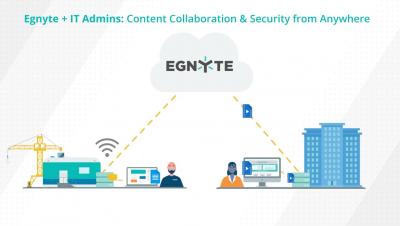Security | Threat Detection | Cyberattacks | DevSecOps | Compliance
August 2021
Assigning Data Owners Quick Tip
Permissions Reviews Quick Tip
Quality Document Management Quick Tip
How to Use Egnyte to Protect Against Insider Threats
Vigilant companies continuously review risks and their cybersecurity postures. They deploy active defense-in-depth measures and utilize the latest malware detection and mitigation techniques. However, there is one type of vulnerability that tends to fall through the cracks—insider threats. That’s because IT organizations often believe it’s management’s problem to address, while managers believe IT groups have insider threats under control.
Complete Content Lifecycle Management in a Single Place
Egnyte’s content lifecycle management solution gives customers full control and flexibility over content at all stages of its lifecycle, from migration of data into Egnyte to managing retention, archival and deletion, and end of life content. Unlike point solutions, Egnyte provides a robust product suite that addresses consolidation of content across repositories, management of content within Egnyte, and content that should be archived. Here's a quick recap of what’s included.
Egnyte can now scan and classify Microsoft Exchange Online emails
Egnyte now offers email scanning and classification of Microsoft Online Exchange emails and attachments. This is a critical capability for organizations that need to deploy consistent document classification and governance across all documents, whether they exist in an Egnyte cloud repository, with other cloud providers, or on premises.
How Egnyte Uses Rate Limiting to Dynamically Scale
Egnyte stores, analyzes, organizes, and secures billions of files and petabytes of data from millions of users. On average, we observe more than a million API requests per minute. As we scale, we have to address challenges associated with balancing throughput for individual users and delivering exceptional quality of service. For example, some Egnyte hosted content that is publicly shared (via our share file and folder links feature) can suddenly go viral.
9 migration considerations to help rein in content sprawl
The past year and a half has posed unprecedented challenges to society, at every level. For companies adjusting to a more distributed workforce, with newly remote workers and no central place of business to anchor their teams, the corresponding flood of unmanaged content and shadow IT has been a serious test of their organizational fortitude. For these companies, business-critical content can go unchecked, dispersed between the cloud and corporate hard drives—a scenario known as content sprawl.
Egnyte + IT Admins: Content Collaboration & Security from Anywhere
Report Shows AEC Firms Face Greater Risk of Ransomware
The AEC industry is very familiar with good risk management. Whether it is managing safety risk, financial risk, legal risk, or project risk, AEC firms are adept at identifying, prioritizing and mitigating risk. Today, the risk of ransomware seems high, with a steady stream of news stories about the latest company to fall victim to an attack. But is it high for everyone in every industry?












